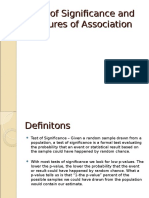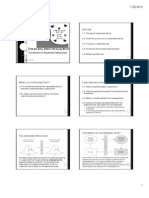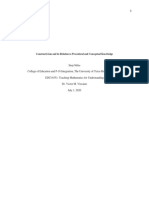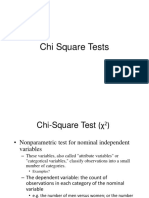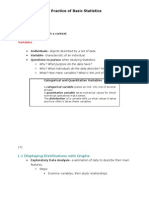Example of Paired Sample T
Example of Paired Sample T
Uploaded by
Akmal IzzairudinCopyright:
Available Formats
Example of Paired Sample T
Example of Paired Sample T
Uploaded by
Akmal IzzairudinOriginal Title
Copyright
Available Formats
Share this document
Did you find this document useful?
Is this content inappropriate?
Copyright:
Available Formats
Example of Paired Sample T
Example of Paired Sample T
Uploaded by
Akmal IzzairudinCopyright:
Available Formats
Example of paired sample t-test
Let us consider a simple example of what is often termed "pre/post" data or "pretest posttest" data. Suppose you wish to test the effect of Prozac on the well-being of depressed individuals, using a standardised "well-being scale" that sums Likert-type items to obtain a score that could range from 0 to 20. Higher scores indicate greater well-being (that is, Prozac is having a positive effect). While there are flaws in this design (e.g., lack of a control group) it will serve as an example of how to analyse such data. The value that we are interested in is the change score, and we obtain it by taking the difference between time 2 and time one. The following snapshot of an SPSS data window provides the data that we can work with.
Figure 6.9 Data for the paired sample t test.
Notice that we have subtracted the first score away from the second to get a difference score or change score. Person #3's well-being score decreased by one point at the post-test. Person #5 increased their well-being score from 4 point to 10 points. The mean of the Pretest data is 3.33 and the mean of the Post test data is 7.0. The question is, "Is this a significant increase?"
Output 6.5 Compare Means -> Paired Sample T test
Step 1: Stating the hypotheses:
Ho: md = 0 H1: md 0
The alternative is two-tailed and alpha = .05
Step 2: Check assumptions
The assumptions underlying the repeated samples t-test are similar to the one-sample t-test but refer to the set of difference scores. 1. The observations are independent of each other 2. The dependent variable is measured on an interval scale 3. The differences are normally distributed in the population. The measures are approximately interval scale numbers (self-report scores) and we assume that each person's score has not been influenced by other people's scores. The numbers look to have no major extremes or unusual distribution.
Step 3: Calculate test statistic
The output is given in Output 6.5. Detailed comments on the output follow. Paired Samples Statistics. Here, the variables being compared are identified, the Mean, N, Standard Deviation, and Standard Error of the Mean for each variable is given.
Paired Samples Correlations. Here the correlation between each of the pairs of variables is given. Because this is a repeated measures analysis, the same people are measured twice. You would expect a high degree of correlation between the two sets of scores. A person who was fairly low well-being score before the treatment should still have a fairly low well-being score relative to the others after the treatment, even if everyone improved (e.g., cases #2). Similarly, someone who had a high well-being score beforehand will probably have one of the highest well-being score afterward (e.g., case #2), even if every one improves by a certain amount. Here the correlation between the two sets of scores is quite minimal for real data (you can tell they were manufactured). There is no consistent pattern of change (see cases #4 and 8). If there is little correlation between the two sets of scores, you might as well be using an Independent Groups T-test. Paired Samples Test. Table 1. Here the descriptive statistics for the difference between each pair of variables is given. The mean difference of 3.67 is what is actually being tested against zero. Is this a large number or a small number? Is this difference a real one or one that we could reasonably expect due to chance alone? Notice the 95% Confidence Interval values are also given here. We do not place much emphasis on these in this unit. This information says that the true population mean lies between 6.357 and -.9763 with a 95% probability. Notice the hypothesised mean of zero does not fall within this range. Paired Samples Test. Table 2. The answer! Here we can determine that the chance of this number occurring by chance alone (given the null hypothesis) is about .014 (or 1.4%).
Step 4: Evaluate the result
The result is significant t(9) = -3.143, p = .012. We reject the null hypothesis in favour of the alternative. Only once or twice out of every 100 times we repeated this experiment (and the null hypothesis was true) would we get a t-statistic of this size. We therefore conclude that it is more likely to have been due to some systematic, deliberate cause. If all other confounds are eliminated, this systematic cause must have been the Prozac drug. 2 = (-3.143) 2/(-3.143) 2 + 9 = 0.523. So, 52.3% of the variability in well-being scores can be explained by the use of the drug or not.
Step 5: Interpret the result
A significant increase in well-being occurred (t(9) = -3.14, p = .012, 2 = .52) in the Prozac treated group compared to the control group. We have found strong evidence that Prozac enhances well-being in depressed individuals. However, the major lack of controls in this study would suggest we keep quiet about it until we can repeat the finding with more stringent safeguards against confounds!
http://www.une.edu.au/WebStat/unit_materials/c6_common_statistical_tests/example_paired_sa mple_t.html
You might also like
- Appropriate Statistics For Ordinal Level DataDocument33 pagesAppropriate Statistics For Ordinal Level DataJohn PriorNo ratings yet
- Development of The Grit Scale For Children and Adults and Its Relation To Student Efficacy, Test Anxiety, and Academic PerformanceDocument10 pagesDevelopment of The Grit Scale For Children and Adults and Its Relation To Student Efficacy, Test Anxiety, and Academic PerformanceRetno Puspa RiniNo ratings yet
- Parametric TestDocument28 pagesParametric TestpaulNo ratings yet
- Stajkovic e Luthans 1998 Self-Efficacy and Work-Related Performance - A Meta-Analysis.Document22 pagesStajkovic e Luthans 1998 Self-Efficacy and Work-Related Performance - A Meta-Analysis.Angela Saraiva Freitas100% (2)
- Sample MT 1 MckeyDocument6 pagesSample MT 1 MckeytortomatoNo ratings yet
- 10 RepeatedMeasuresAndMixedANOVADocument30 pages10 RepeatedMeasuresAndMixedANOVACristina Roxana SarpeNo ratings yet
- Advanced Management Accounting - SampleDocument48 pagesAdvanced Management Accounting - SampleMarcellin MarcaNo ratings yet
- SDGP CW 1 - SRS Template and GuidelinesDocument11 pagesSDGP CW 1 - SRS Template and GuidelinesPrabageshwaran HabithanNo ratings yet
- Design Manual LVSRs Malawi (2013)Document185 pagesDesign Manual LVSRs Malawi (2013)alwil1445480% (1)
- Mathematical ResilienceDocument5 pagesMathematical Resilienceapi-298719124100% (1)
- TIMSS Assessment Framework Outline (Group 3)Document7 pagesTIMSS Assessment Framework Outline (Group 3)heystobitNo ratings yet
- One and Two Way ANOVADocument11 pagesOne and Two Way ANOVADave MillingtonNo ratings yet
- Assumptions and Properties of Z and T DistributionDocument4 pagesAssumptions and Properties of Z and T DistributionAdnan AkramNo ratings yet
- T-Test or Z-Test DecisionDocument11 pagesT-Test or Z-Test Decisionkami_r202No ratings yet
- Math AnxietyDocument14 pagesMath Anxietyroylepayne100% (1)
- Statistics Using Stata An Integrative Approach: Weinberg and Abramowitz 2016Document46 pagesStatistics Using Stata An Integrative Approach: Weinberg and Abramowitz 2016Ramisa FarihaNo ratings yet
- Chi SquareDocument11 pagesChi Squareujwala_512No ratings yet
- Statistics 2Document4 pagesStatistics 2waleed100% (1)
- Lesson 12 T Test Dependent SamplesDocument26 pagesLesson 12 T Test Dependent SamplesNicole Daphnie LisNo ratings yet
- Statistics ProjectDocument6 pagesStatistics ProjectMimimiyuhNo ratings yet
- Hypothesis Testing Sample WorksheetDocument19 pagesHypothesis Testing Sample WorksheetJuliana BudomoNo ratings yet
- Chi Square TestDocument75 pagesChi Square Testdrmsupriya091159100% (1)
- The Scheffé Test and The Tukey TestDocument14 pagesThe Scheffé Test and The Tukey TestAutumn LlorenNo ratings yet
- Statistics and Freq DistributionDocument35 pagesStatistics and Freq DistributionMuhammad UsmanNo ratings yet
- Analysis of Variance AnovaDocument30 pagesAnalysis of Variance Anovahardy1997100% (1)
- Tests of Significance and Measures of AssociationDocument21 pagesTests of Significance and Measures of Associationanandan777supmNo ratings yet
- Chi Square and McNemar TestDocument45 pagesChi Square and McNemar Testjimoh olamidayo MichealNo ratings yet
- Marketing Research Study NoteDocument18 pagesMarketing Research Study NoteAaron Pinto100% (1)
- Tabular and Graphical Descriptive Techniques Using MS-ExcelDocument20 pagesTabular and Graphical Descriptive Techniques Using MS-ExcelVarun LalwaniNo ratings yet
- Hypothesis Testing With One Sample: Larson & Farber, Elementary Statistics: Picturing The World, 3e 3Document23 pagesHypothesis Testing With One Sample: Larson & Farber, Elementary Statistics: Picturing The World, 3e 3S.WaqquasNo ratings yet
- Chi SquareDocument13 pagesChi SquareRISHAB NANGIANo ratings yet
- Day 11 & 12 - Hypothesis TestingDocument6 pagesDay 11 & 12 - Hypothesis TestingLianne SedurifaNo ratings yet
- Concept of Research DesignDocument157 pagesConcept of Research DesignVishal ShuklaNo ratings yet
- Lecture 26 - Sampling Distribution Proportion PDFDocument41 pagesLecture 26 - Sampling Distribution Proportion PDFsound05No ratings yet
- Chapter 2, Discriptive StasticsDocument86 pagesChapter 2, Discriptive StasticsZeyinu Ahmed MohNo ratings yet
- Basic Concepts in StatisticsDocument19 pagesBasic Concepts in StatisticsMILBERT DE GRACIANo ratings yet
- Peer Tutoring & Teacher Remediation in ICF-8 RP - Draft 20190602 PDFDocument12 pagesPeer Tutoring & Teacher Remediation in ICF-8 RP - Draft 20190602 PDFJerry EspinosaNo ratings yet
- The History of StatisticsDocument1 pageThe History of StatisticsJharylAcostaNo ratings yet
- Descriptive Research - Tampocao&cerilo R.Document66 pagesDescriptive Research - Tampocao&cerilo R.Jelyn MamansagNo ratings yet
- Nominal, Ordinal, Scale VariableDocument14 pagesNominal, Ordinal, Scale Variableguru9anandNo ratings yet
- Constructivism and Its Relation To Procedural and Conceptual KnowledgeDocument5 pagesConstructivism and Its Relation To Procedural and Conceptual Knowledgeapi-325255998No ratings yet
- 44 2 Two Way AnovaDocument25 pages44 2 Two Way AnovaEbookcraze100% (1)
- CH 10 Skewness KurtosisDocument17 pagesCH 10 Skewness KurtosisiamakingNo ratings yet
- Lecture One Way ANOVADocument22 pagesLecture One Way ANOVAAnum ShahzadNo ratings yet
- Ed - MathMajor12 Elementary Statistics and PRobabilityDocument3 pagesEd - MathMajor12 Elementary Statistics and PRobabilityHans RomeroNo ratings yet
- Basic Anova PDFDocument6 pagesBasic Anova PDFEmmanuel Jimenez-Bacud, CSE-Professional,BA-MA Pol SciNo ratings yet
- Teacher Survey Learning Loss Is Global and SignificantDocument10 pagesTeacher Survey Learning Loss Is Global and SignificanttelegenicsNo ratings yet
- Basic SPSSDocument14 pagesBasic SPSShasna lidasanNo ratings yet
- ANCOVADocument17 pagesANCOVAErik Otarola-CastilloNo ratings yet
- Geometric MeanDocument2 pagesGeometric MeanMuiz HassanNo ratings yet
- Chi Square TestDocument11 pagesChi Square TestdavidrajshadrachNo ratings yet
- StatisticsDocument26 pagesStatisticscherryNo ratings yet
- Testing The Difference Between ProportionsDocument20 pagesTesting The Difference Between ProportionsOteng Richard Selasie100% (2)
- Global Challenges WaterDocument2 pagesGlobal Challenges WaterYong PrazNo ratings yet
- 12 Chi SquareDocument31 pages12 Chi SquareBagus MahendraNo ratings yet
- Joint Probability DistributionDocument10 pagesJoint Probability DistributionJawad Sandhu100% (1)
- Teatchers Sense of Efficacy and The Organizational Health of SchoolsDocument19 pagesTeatchers Sense of Efficacy and The Organizational Health of SchoolsVanessa RagoneNo ratings yet
- IKM - Sample Size Calculation in Epid Study PDFDocument7 pagesIKM - Sample Size Calculation in Epid Study PDFcindyNo ratings yet
- Theory-Based Instructional Models Applied in Classroom ContextsDocument10 pagesTheory-Based Instructional Models Applied in Classroom ContextsMahathir FansuriNo ratings yet
- Introduction To The Practice of Basic Statistics (Textbook Outline)Document65 pagesIntroduction To The Practice of Basic Statistics (Textbook Outline)Eugene Johnson100% (14)
- Wilcoxon Signed-Ranks TestDocument16 pagesWilcoxon Signed-Ranks TestLayan MohammadNo ratings yet
- Chapter 6Document6 pagesChapter 6Thakur RajendrasinghNo ratings yet
- T Test Function in Statistical SoftwareDocument9 pagesT Test Function in Statistical SoftwareNur Ain HasmaNo ratings yet
- Chapter 7 - Sampling DistributionDocument7 pagesChapter 7 - Sampling Distributionbishoy sefinNo ratings yet
- Manual of Fish Sclerochronology-Ifremer PDFDocument466 pagesManual of Fish Sclerochronology-Ifremer PDFDaniela Mariana RosioruNo ratings yet
- Its Like An Overlap From The TextDocument4 pagesIts Like An Overlap From The TextFachrul Budi PrayogaNo ratings yet
- Statppt4 - Z, T, F & Chi-Square Test FormulasDocument42 pagesStatppt4 - Z, T, F & Chi-Square Test FormulaspogggigigieigegnNo ratings yet
- Why Young Filipino Teachers TeachDocument14 pagesWhy Young Filipino Teachers TeachJego SorianoNo ratings yet
- A Model of Six-Step Process of Employee Motivation: November 2012Document10 pagesA Model of Six-Step Process of Employee Motivation: November 2012CarryOutSeries SeriesNo ratings yet
- Prophasedx Laboratory Phone: (855) 982-1100Document2 pagesProphasedx Laboratory Phone: (855) 982-1100ommanon15 aNo ratings yet
- Practical Research IIDocument225 pagesPractical Research IIJulianne71% (17)
- The Effect of Digital Marketing On Purchasing Decisions: A Case Study in JordanDocument10 pagesThe Effect of Digital Marketing On Purchasing Decisions: A Case Study in JordanKristine DestorNo ratings yet
- Reservation System Literature ReviewDocument5 pagesReservation System Literature Reviewjylavupovip2100% (1)
- A Continual Learning Survey Defying Forgetting in Classification TasksDocument20 pagesA Continual Learning Survey Defying Forgetting in Classification TasksmoazamfrazNo ratings yet
- Direction For Project Report Submission-:: ND THDocument5 pagesDirection For Project Report Submission-:: ND THSheetal AhujaNo ratings yet
- Assestment 2 Project PortfolioDocument11 pagesAssestment 2 Project Portfoliotuners baluarteNo ratings yet
- What Is The Biggest Problem With Concrete Core TestingDocument2 pagesWhat Is The Biggest Problem With Concrete Core TestingLim Lip BoonNo ratings yet
- The Tempest Homework IdeasDocument6 pagesThe Tempest Homework Ideasg3nywwrn100% (1)
- Building and Environment: Alan Kabanshi, Hans Wig O, Robert Ljung, Patrik S OrqvistDocument11 pagesBuilding and Environment: Alan Kabanshi, Hans Wig O, Robert Ljung, Patrik S OrqvistJorgeNo ratings yet
- Request For Proposal - WikipediaDocument5 pagesRequest For Proposal - WikipediamoNo ratings yet
- Eng 102 Project ProposalDocument4 pagesEng 102 Project Proposalapi-484421622No ratings yet
- Article 1 - Understanding Machine Learning - Concepts and ApplicationsDocument3 pagesArticle 1 - Understanding Machine Learning - Concepts and Applicationsjuliaevan3No ratings yet
- The Impact of COVID-19 Lockdown On Palliative Care Services in MalaysiaDocument2 pagesThe Impact of COVID-19 Lockdown On Palliative Care Services in MalaysiaInstitute for Clinical ResearchNo ratings yet
- Precena Strategic Partners ORBG10Document8 pagesPrecena Strategic Partners ORBG10Tanmaya Ranjan MishraNo ratings yet
- + AJO 2021 Reliability of 2 Methods in Maxillary Transverse Deficiency DiagnosisDocument8 pages+ AJO 2021 Reliability of 2 Methods in Maxillary Transverse Deficiency DiagnosisGeorgeJCNo ratings yet
- Once-Monthly Injection of Paliperidone Palmitate ADocument12 pagesOnce-Monthly Injection of Paliperidone Palmitate AMaria Fernanda AbrahamNo ratings yet
- Career Indecision and Career Anxiety in High SchooolDocument19 pagesCareer Indecision and Career Anxiety in High SchooolP.CNo ratings yet
- Random ForestDocument32 pagesRandom ForestHJ ConsultantsNo ratings yet
- EducationDocument5 pagesEducationBongbong Gallo100% (6)
- Research ProposalDocument14 pagesResearch ProposalRomielyn MenguezNo ratings yet

























